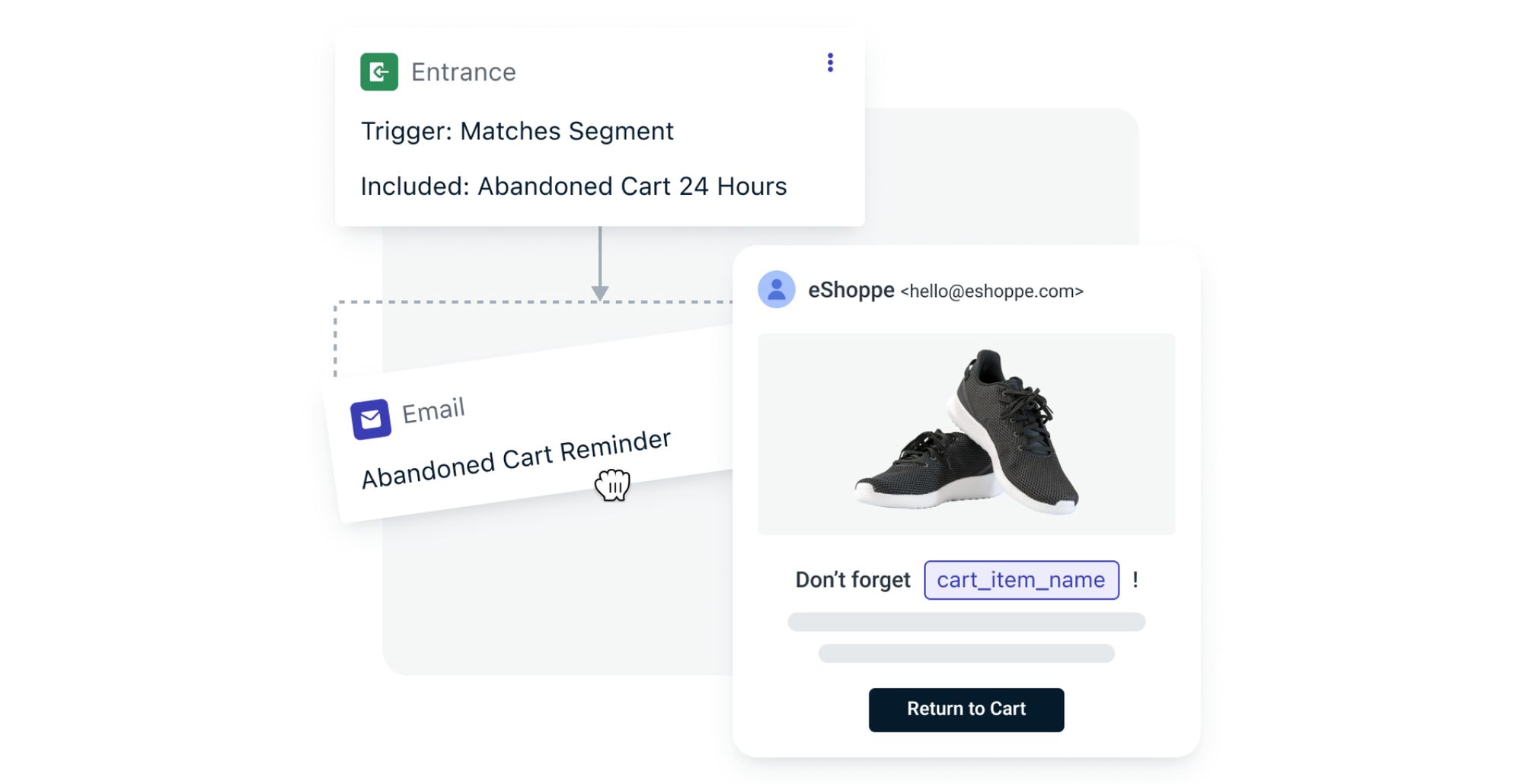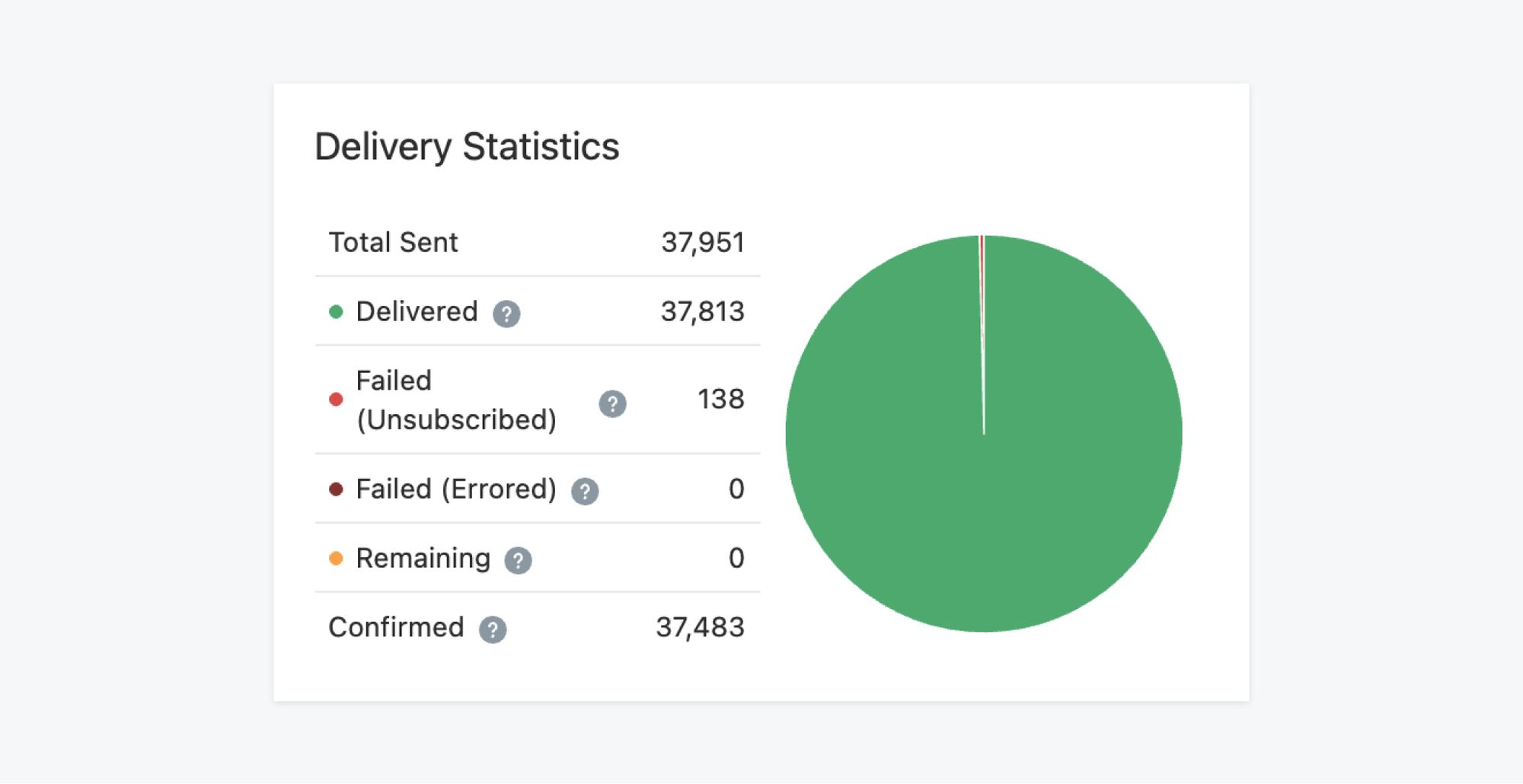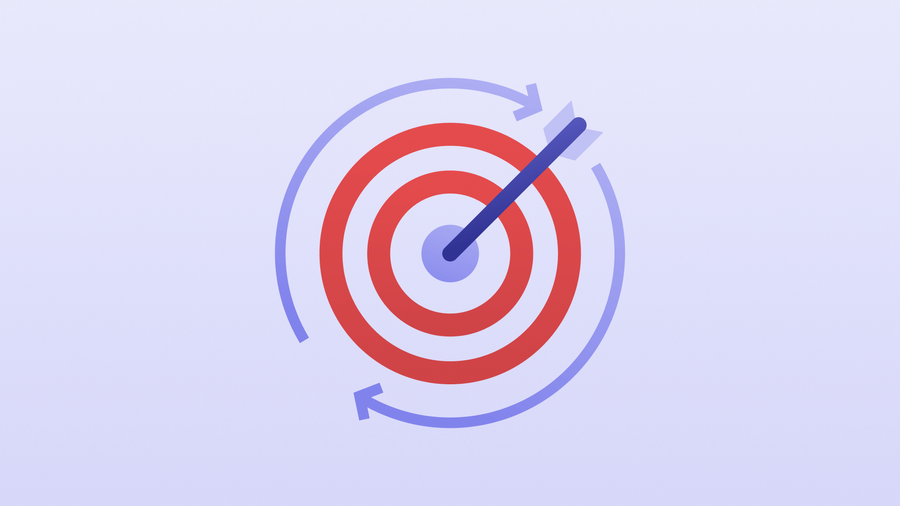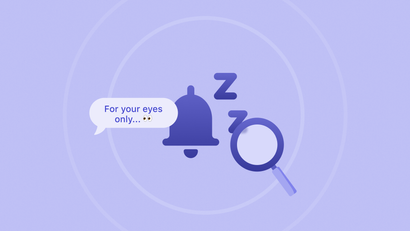With 73% of mobile app users churning after 90 days, you can’t rely on (or afford) new user acquisition as a primary revenue source. Retargeting is a proactive approach to reach users who are already in your funnel to maximize the effectiveness of your marketing efforts and capitalize on existing intent.
What are Retargeting Messages?
Retargeting messages are personalized communications or notifications sent to users who have previously interacted with your brand's mobile app or website. These messages can take various forms, from in-app messages to re-engagement emails, and are designed to reactivate your audience based on exactly where they are in the user journey. By targeting users with personalized messages at different stages of their journey, you can deliver precisely targeted content or offers, delivering them the incentive they need to return to your app and spark engagement.
All re-targeting campaigns are triggered by specific user behavior, such as:
- Abandoned Cart: When a user adds items to their cart but doesn't complete the purchase.
- Inactivity: When a user hasn't engaged with the app or website for a specified period.
- Previous Purchases: When a user has made a purchase in the past, triggering recommendations for related products or complementary items.
- Browsing History: When a user has viewed specific products or categories, prompting personalized recommendations or discounts for those items.
- Email Open or Click: When a user opens or clicks on an email, triggering follow-up messages across other channels.
- App Install or Sign-Up: When a user installs the app or signs up for an account, initiating a series of onboarding messages or special offers.
- Subscription Renewal: When a user's subscription is about to expire or has lapsed, prompting renewal reminders or incentive offers.
- Event Attendance: When a user registers for or attends an event, triggering follow-up messages with related content or offers.
- Location-Based Activity: When a user visits a physical store or location, triggering personalized messages or promotions based on their geolocation (known as geotargeting)
- Social Media Engagement: When a user interacts with the brand's social media posts or ads, prompting follow-up messages or offers across other channels.
By leveraging multiple channels, you ensure that your messages reach users wherever they are and when they're most likely to be receptive. Whether it’s an opportunistic push notification on their lunch break or a cart recovery SMS reminder at the end of the work day, this targeted approach helps to prevent users from churning by directly responding to their personal points of friction with your brand.
Retargeting Ads vs Message Retargeting
84% of users either ignore or are put off by retargeting ads. Whereas retargeting ads serve users targeted paid ads across the web, message retargeting organically and proactively targets users over communication channels they’ve already opted into. By leveraging push notifications, in-app messages, email, and SMS for your retargeting campaigns, you can increase re-engagement rates and nurture brand loyalty.
Who Can Benefit From Retargeting?
Regardless of industry or category, virtually any app or mobile website can leverage cross-channel retargeting to reach inactive users and even help drive conversions.
In addition to re-capturing lost revenue from abandoned carts, retargeting can be used to encourage app users to complete specific actions, join new challenges or user groups, take advantage of personalized offers or content, and much more.
Because it's cheaper to win back users who are already in your ecosystem than to acquire new users from scratch, retargeting messages is a cost-effective (and often necessary) engagement strategy for any app or website.
How to Create Multichannel Retargeting Campaigns
Message retargeting hinges on audience research and meticulous personalization to yield the best results. Each message should have explicit intent informed by real user behavior and provide value to recipients.
From the user's perspective, a strong retargeting campaign appears seamless and cohesive, delivering timely and personalized messages that address their most pressing interests and concerns. Offers, incentives, or in-app tips should all remain contextually relevant to the channel they are being communicated over. Message fatigue can hinder your results, so be mindful of over-messaging as you create your campaigns.
Below is a step-by-step overview of the anatomy of a message retargeting campaign.
1. Segment Your Audience
The first step is to segment your audience based on their behavior, preferences, and past interactions with your app or website. This targeted approach ensures that retargeting messages are not only personalized but also delivered through the most relevant and impactful channels.
An example of OneSignal’s audience segment editor, which in this case is set to target users who have not returned to the site or app in over 10 days.
With the right customer engagement platform, you can fine-tune your audience segmentation to reach previously untouched user cohorts and do so at scale. OneSignal’s robust audience segmentation platform supplies you with pre-built user segments to help you get started immediately and custom data tags to help you hone in on endless demographic or activity-based user groups.
2. Select the Right Communication Channel
Identify the most appropriate channels for your retargeting campaign based on your audience's preferences and where they are most likely to engage. This may include channels such as push notifications, SMS, email, or in-app messaging.
For instance, one of your segmented lists may contain users who demonstrated prior engagement with your app but have remained dormant for a short period of time. Push notifications offer the immediacy needed to grab the attention of users who are familiar with your site or app, but need a real-time nudge back in the right direction.
This web push notification from Blue Wizard Digital targets players who have managed to score high numbers but have since been inactive by incentivizing them with an in-game currency.
Consider another example of an audience segment that has signed up for a free trial of your service but has not yet converted into a paying customer. You can effectively nurture these leads and guide them toward conversion by sending personalized follow-up emails with tips, tutorials, success stories, or special offers tailored to their usage patterns and needs. This segment will likely be receptive to email retargeting and may appreciate additional resources, detailed incentives, or extra context to help them make an informed decision.
3. Personalize Message Content
Create personalized cross-channel content that resonates with your audience's interests and motivations. This may include personalized product recommendations, exclusive offers, or reminders tailored to their past interactions.

Abandoned cart notifications are one of the best ways to target users who came close to making a purchase but lapsed at checkout. Make it easy for them to return and complete their purchase — show them exactly what they left behind!
By referencing the user's past browsing behavior and offering a relevant discount, you'll ensure that messages resonate with the users and incentivize them to re-engage.
In-App Message Example:
[Notification Title]: "Still Interested in [Product Category]?"
[Message]: "Hi [User], We noticed you recently browsed our collection of outdoor gear. As a dedicated part of our family, we thought we’d share a limited-time 20% discount offer! Tap here to start gearing up!"
SMS Alert Example:
[Sender]: OutdoorStore
[Message]: "Hi [User], there’s only [remaining promo time] left on your special offer! Get 20% off your next [product category] with code CAMP20. We have a limited stock, so don’t drag your hiking boots! 🥾🌲"
Where the first in-app message example capitalizes on user loyalty and product preference, the follow-up SMS alert uses more urgent language to create FOMO and encourage immediate action.
4. Optimize Send Time
Determine the optimal timing for delivering your retargeting messages on each channel. Consider factors such as time of day, day of the week, and user behavior patterns to maximize engagement and response rates. Tagging users based on key interactions, milestones, and preferences, will empower you to automate and personalize your re-engagement campaigns in real-time. Automating this process will ensure that every user is "nudged" at exactly the right moment in their user journey.
The best engagement solutions can help you hone your message timing even further. For instance, our Intelligent Delivery uses past behavior analytics to predict, schedule, and send your messages at the optimal time for each user.
5. Create a Cohesive Omnichannel Experience
Coordinate your retargeting efforts across multiple channels to ensure a cohesive and consistent user experience. This may involve synchronizing messaging content, timing, and frequency across different channels to reinforce your message and avoid overloading users.
OneSignal’s omnichannel messaging builder, Journeys, is designed for this exact purpose. Simply choose your audience segments, select your preferred mobile channels, and input your custom wait time triggers to map an airtight (and automated) retargeting sequence.
Since we’re in the business of making things ridiculously easy, Journeys requires no coding or need to rely on complex engineering resources. Just drag, drop, and send. View more Journeys examples to see it in action!
6. Track Engagement and Analyze Results
Implement tracking mechanisms to monitor the performance of your retargeting campaign across various channels. Analyze key metrics such as click-through rates, conversion rates, and ROI to assess the effectiveness of your campaign and make data-driven optimizations.
If your click-through rate (CTR) is not improving in your retargeting strategy, it may be beneficial to reassess your messaging content and targeting approach. Consider experimenting with different messaging formats, visuals, or calls-to-action to make your retargeting messages more compelling and engaging for your audience. Additionally, review your audience segmentation strategy to ensure that you are effectively targeting users who are most likely to respond positively to your messages.
On the other hand, if your conversion rate is not improving, focus on optimizing the user journey and removing any friction points that may be hindering conversions. This could involve streamlining the checkout process, offering clearer incentives or benefits, or providing additional support or information to help users make informed decisions.
One of the best ways to track retargeting campaign outcomes is through Confirmed Deliveries. Confirmed Deliveries allows OneSignal senders to receive device-level confirmation of every successfully delivered message, giving you a clearer picture of your messaging pipeline health and more accurate CTR data along the way.

To learn more about tracking retargeting outcomes and navigating “phantom subscribers” explore our Confirmed Deliveries Guide!
7. Optimize as You Go
Continuously optimize your retargeting campaign based on real-time performance data and user feedback. Adjust your targeting criteria, messaging content, and channel mix to improve engagement, conversion, and overall campaign effectiveness over time.
For example, a mobile gaming app that sends out a generic push notification to all inactive users, reminding them to return may experience lower than desired conversion rates.
To address this, they might adjust their targeting criteria to focus on users who have previously shown interest in specific game features or genres, such as users who have completed certain levels or participated in multiplayer battles. Next, they can update the messaging content to be more personalized and enticing, offering rewards such as bonus coins, power-ups, or exclusive in-game content tailored to the user's gaming preferences. They might also experiment with different times of day to send the notifications, recognizing that users may be more receptive to gaming-related messages during certain hours.
Message retargeting is an ongoing process, not a one-time-only strategy. The more you refine your audience segments and channel sequences, the stronger your results will be.
Open Up New Retargeting Opportunities With OneSignal
Between OneSignal’s robust segmentation suite, dynamic omnichannel Journeys Builder, and best-in-class documentation, there is no shortage of retargeting opportunities waiting to be discovered within your existing user base. We have a variety of pricing plans for businesses at every stage. If you’d rather test the waters, we wouldn’t blame you — our Free Plan is th perfect place to give us a try!
Get Started for Free



